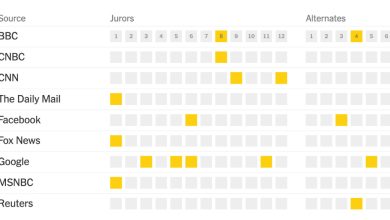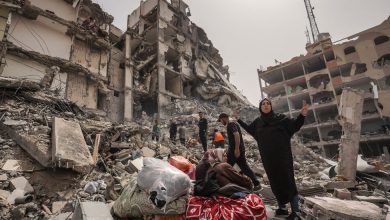New York’s Most Generous Tax Break Could Bite the Dust

Good morning. It’s Friday. We’ll look at the end of an expensive real estate subsidy that has shaped the city since the 1970s. We’ll also look at inequality in parks and pools.

Huge projects in Manhattan have taken advantage of the tax incentive over the years.Credit…Brittainy Newman/The New York Times
Since 1971, nearly every big residential real estate project in New York City has taken advantage of a subsidy known as 421a.
It is the city’s most generous tax break, costing it $1.77 billion a year in lost tax revenue.
And in little more than three weeks, it will probably go the way of leisure suits, pet rocks and the Ford Maverick.
The State Legislature is unlikely to renew the subsidy before it expires on June 15. Worried builders have been rushing to break ground on new projects to qualify for 421a before then, particularly in the Gowanus area of Brooklyn, which was rezoned for large-scale residential projects last year.
Governor Kathy Hochul pushed for a revised and rebranded version of 421a, but she did not find support in the Democrat-controlled Legislature. Lawmakers and real estate industry officials say there was reluctance to renew a lucrative tax break for the real estate industry before the November elections.
“A lot of people have very serious reservations about 421a as currently constituted,” said Assemblyman Jeffrey Dinowitz, a Democrat who represents parts of the Bronx, adding, “I just don’t think we’re getting our money’s worth with 421a.”
Developers were usually required to build some below-market rentals in exchange for the tax breaks on market-rate apartments and condominiums. But the provision’s critics say it amounted to a giveaway because developers kept the mix of low-income units as lean as they could.
“421a is a broken, absurdly expensive Band-Aid placed on top of New York City’s broken property-tax system,” said Brad Lander, the city’s comptroller, who has pressed for the end of the tax break. “It’s good that it is not being renewed.”
The impact of allowing it to expire won’t be felt for several years. Matthew Murphy, the executive director of New York University’s Furman Center for Real Estate and Urban Policy, said 421a rental projects underway now would take time to complete. After that, he predicted, developers will favor condominiums, which generate higher returns.
But ending 421a won’t make an expensive city more affordable.
“All it does is introduce a huge amount of uncertainty in development,” he said, “and exacerbate the housing shortage in the long run.”
Weather
Expect a cloudy day, with temps climbing into the high 70s. There could be light rain in the morning. Showers are likely later, with overnight temps falling to the mid 60s.
ALTERNATE-SIDE PARKING
Suspended on Monday (Memorial Day).
The latest New York news
Local News
-
Trumps under oath: A state appeals court ruled that Donald Trump and two of his adult children must sit for questioning under oath as part of the New York attorney general’s civil investigation into their business practices.
-
Wi-Fi access: City Limits reports that because of a legal settlement in a class-action case, more than 240 family homeless shelters now have internet access.
Climate & Environment
-
Tree hugging: The Times caught up with Eileen Myles, the poet and author of “Chelsea Girls,” who has been guarding trees in Lower Manhattan.
-
Artificial snow: The skiing industry in New York State must learn to adapt to a changing climate, The Village Voice reports.
Arts & Culture
-
DanceAfrica returns: The DanceAfrica festival is back at the Brooklyn Academy of Music for the first time since 2019. And just as in the festival’s early years, all the participating companies are local.
-
Get inked: Looking to get a tattoo? Curbed has a list of the best tattoo artists in the city, from shops that take same-day appointments to artists who specialize in fake freckles.
Pools, parks and inequality
Many of us will think about hitting the beaches or relaxing in the parks this Memorial Day weekend. But in aging cities like New York, summer isn’t all joy. Heat kills about 350 New Yorkers a year, and the risk is not shared equally. Black New Yorkers are more than twice as likely to die from heat as white residents, according to city data. I asked my colleague Anne Barnard to discuss inequalities that New Yorkers see every day without always realizing their impact.
Life is unfolding in public spaces again as New York returns, somewhat fitfully, from the pandemic. Anyone is supposed to be able to take advantage of parks, public pools and libraries. But the facilities are not the same from neighborhood to neighborhood, are they?
No. All last summer, New York Times reporters roamed the city to see how the differences affect people’s lives. What we learned points to who will suffer most in the heat this summer.
Consider this: In Crotona Park East in the Bronx, 41 percent of residents fall below the federal poverty line, 24 percent of households lack air-conditioning and few have cars to reach beaches or forests.
By contrast, in Carnegie Hill on the Upper East Side, one of the city’s wealthiest, whitest sections, 96 percent of the households are air-conditioned. And so many residents there have the money and the flexibility to leave town in the summer that during the hottest weeks last year, some streets felt empty. Central Park is nearby, but many in Carnegie Hill weren’t around to take advantage of it.
New York built grand, elegant public pools in the 1930s. They were symbols of civic pride and public investment. What about now?
New York has less than one pool per 100,000 residents. That’s fewer than most U.S. cities, with more per capita in Manhattan and Staten Island, the wealthiest boroughs, according to the Trust for Public Land.
Black and Latino children trail in access to swimming lessons and drown at higher rates. And, in fact, many New York pools remain largely segregated.
Amid the tensions of the late 1960s, the city opened smaller pools in underserved Black and Latino neighborhoods. But restrictions imposed in response to violence at the pools limit what people can carry beyond the changing areas. Such rules created what Jesse Amaro, who lives in the Bronx, called “a prison-yard mentality” when we talked with her as she waited to get into the Crotona Pool one afternoon last summer.
Mark Focht, a deputy parks commissioner, said the city is working to improve pools in the hottest, neediest areas. Sixteen aging pools across the city have gotten upgrades costing nearly $5 million, he said, giving them “the vibe of a country club or resort.”
But it’s fair to say that the grandest pools still fall short of past glory.
Is the problem too little money?
Eric Adams, first as a candidate and more recently as mayor, said he would adjust parks spending to a new baseline, 1 percent of the city’s budget. That would amount to around $1 billion, but his proposed budget included only about half that amount. His deputy press secretary, Charles Lutvak, said in an email that the budget represented “a down payment on his ‘Percent for Parks’ pledge” and that the full amount will be reached at some point while Adams is in office.
METROPOLITAN diary
Alternate reward
Dear Diary:
I live in northern Queens and never drive into Manhattan if I can help it. But one Sunday afternoon when I was sitting at home, I remembered that when I had returned from work Friday night, I had parked in a spot with Monday street cleaning from 9:30 to 11 a.m. and that I had a 10 a.m. appointment in Manhattan on Monday.
I headed out to try to find a spot that didn’t require me to move the car the next day. After circling several nearby blocks, I realized that the only available spots would force me to do just that. Everything else was full.
Accepting my fate, I found a possible space in front of my building. It was near a hydrant and actually big enough for two cars, but one was already parked there in a way that barely left enough room for mine.
Nevertheless, I pulled in and had begun to back up when I realized the driver was in the car that was there. I got out of my car and approached him.
“Are you going to be here until tomorrow morning?” I said. “I want to back up against you so I’m not in the fire hydrant zone.”
“What time do we have to move tomorrow?” he asked
“9:30,” I said, “but I’ll be gone long before then.”
“No problem,” he said. “Go for it.”
I jumped into my car and backed up to within 6 inches of his bumper. As I got out of the car, he called out to me.
He was holding out a long slender package in a white bread bag.
“Take this!” he said.
“What is it?” I asked
“A baguette. I have two! It’s fresh.”
“Did you make this?”
“Yes, enjoy it.”
“Wow! Thanks, I will.”
I turned and walked into my building, trying to decide what I would have with my fresh baguette.
— G. Victor Paulson
Illustrated by Agnes Lee. Send submissions here and read more Metropolitan Diary here.
Glad we could get together here. — J.B.
P.S. Here’s today’s Mini Crossword and Spelling Bee. You can find all our puzzles here.
Emma Grillo, David Moll and Ed Shanahan contributed to New York Today. You can reach the team at [email protected].
.



